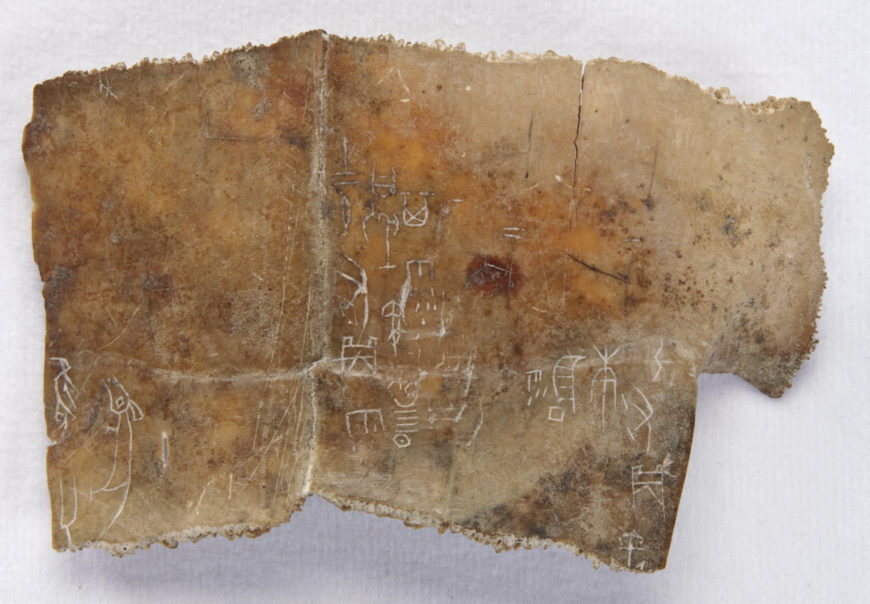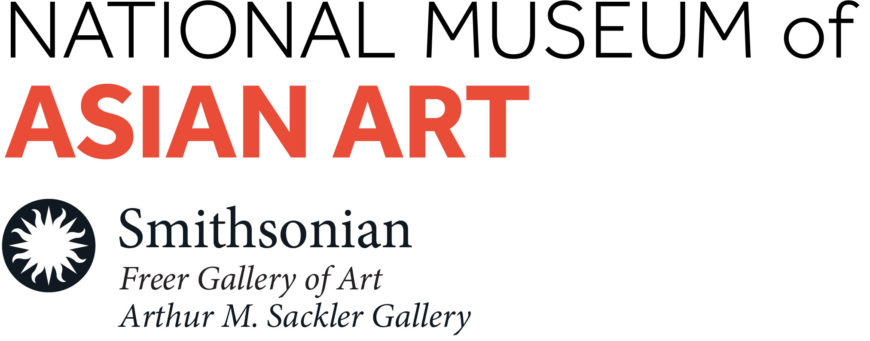Oracle Bone, Shang Dynasty, Reign of Zu Geng, c. 1191-1181 B.C.E. (Shanghai Museum, China)Speakers: Dr. Kristen Chiem and Dr. Beth Harris
[0:00] [music]
Dr. Beth Harris: [0:04] We’re in the Shanghai Museum, and we’re looking at a very early oracle bone. This is so important, because this brings us to the very beginnings of writing in ancient China.
Dr. Kristen Chiem: [0:16] The oracle bone is on an ox scapula, so it’s actually the shoulder blade, here, that you can see carved [with] little tiny characters from the right to the left, all in little lines.
Dr. Harris: [0:25] Those characters are still, many of them, recognizable as Chinese characters today.
Dr. Chiem: [0:31] Yeah, about 40 percent of them actually are decipherable, and we have tons of these remaining. We have about 200,000 of them.
Dr. Harris: [0:36] We’re not really used to the idea in the West that we could read writing that’s more than 3,000 years old.
Dr. Chiem: [0:43] Of course, this is really important because you can read history through it. When we have a group of these objects together, we can look back and see how things evolved on this particular year, what kinds of concerns people had.
Dr. Harris: [0:55] It’s an oracle bone, so we know that it was something that could divine the future, that could help people understand what the future might bring.
Dr. Chiem: [1:02] They would get these bones, they would inscribe the questions on them, and then a diviner would come and use a particular ritual that involved a heated rod, a metal rod, that they would touch to the bone. The way that the cracks would evolve on the questions would divine the future.
Dr. Harris: [1:19] The cracks would be read by someone who had a kind of special power.
Dr. Chiem: [1:23] The questions were all directed toward somebody named Shangdi, the deified ancestor of the Shang royal cult. We’re talking about the Shang Dynasty, in the cradle of civilization — the Yellow River valley, the capital.
[1:35] The kinds of questions people would ask would involve everything from the very mundane to ritualistic things. When should a sacrifice be performed, a particular rite of worship. This one we’re looking at, a question about the bumper harvest, when to be planting.
Dr. Harris: [1:48] Ancestor worship was incredibly important during the Shang Dynasty, and that’s something that will change with the next dynasty, the Zhou Dynasty.
Dr. Chiem: [1:57] Yeah, when we get into the Zhou we see a different concept of the divine.
Dr. Harris: [2:00] Shangdi was the particular ancestor/god of the Shang Dynasty.
Dr. Chiem: [2:06] Yes, exactly.
Dr. Harris: [2:07] Of course, it makes sense with the next dynasty, you would have to adjust that. We see these on, especially on scapula of oxen, but also other animal bones and also tortoiseshell.
Dr. Chiem: [2:18] Tortoiseshell was another favorite medium, probably also because tortoise was an important mythological creature from very early times. Here you can see that the medium itself is very flat, it’s a good surface to carve into.
[2:31] When we’re looking at these kinds of things, keep in mind that this is what we have. We have bones. These stood the test of time, but that doesn’t mean that there wasn’t also writing on other things.
Dr. Harris: [2:40] The writing that we’re seeing, we know that Chinese characters stand for words. Perhaps, at this time in history, the signs that we’re seeing are more pictographic until it evolves.
Dr. Chiem: [2:51] Yeah, they’ve been slowly decoded. Actually, art historians have spent quite a bit of time trying to decipher this enough so that we can read them. At this point, writing is a functional medium. It’s to communicate, in this example, with the gods. Eventually, it evolves into calligraphy, which becomes this art form.
Dr. Harris: [3:08] The importance of Chinese writing here in this very early moment.
Dr. Chiem: [3:13] A lot of major developments in Chinese society, right: we’ve got centralized power as a major theme coming out of the writing, the idea that people can communicate and organize, and this idea of creating a history here.
Dr. Harris: [3:24] So lucky that we can at least untangle 40 percent of it, of these thousands of bones that survived.
Dr. Chiem: [3:30] Exactly.
Dr. Harris: [3:30] One day we’ll understand even more of them.
Dr. Chiem: [3:33] Even more of them, exactly.
[3:34] [music]
The Shang dynasty (1600–1050 B.C.E.) saw advancements made in mathematics, astronomy, and bronze casting technology. It is considered the first historical dynasty of China, meaning it left behind written records. These records are preserved as engravings cut into the so-called oracle bones.

Inscribed tortoise carapace (“oracle bone”), Anyang period, late Shang dynasty, c. 1300–1050 B.C.E., tortoise shell, China, 6.5 high x 10.8 x 2.3 cm (Arthur M. Sackler Gallery, Smithsonian Institution, Washington, D.C.: The Dr. Paul Singer Collection of Chinese Art of the Arthur M. Sackler Gallery, Smithsonian Institution, Washington, DC; a joint gift of the Arthur M. Sackler Foundation, Paul Singer, the AMS Foundation for the Arts, Sciences, and Humanities, and the Children of Arthur M. Sackler, S2012.9.445)
The term “oracle bone” refers to ox scapulae (or shoulder blade bones) and tortoiseshells used by Shang rulers for divination. Oracle bones were said to offer a conduit to the spirits of royal ancestors, legendary figures from the past, nature deities, and other powerful spirits. Shang kings asked about natural events, illnesses, dreams, and forecasts for hunting and military endeavors.
Under the direction of the king and his diviner, the bones of cattle and water buffalo and the shells of tortoises were scraped clean, polished, and perhaps soaked. When dry, the bones or shells were chiseled to produce rows of grooves and pits. During the ritual, a diviner would insert a heated rod into the bottom of the grooves and pits to produce hairline cracks on the opposite side of the bone or shell. The diviner requested information and guidance from the spirit of a royal ancestor and then interpreted the direction of the cracks to provide answers to the king’s question. To record the king’s question, a scribe would then carve it onto the bone or shell surface relative to the cracks.
Later, the scribe would carve the outcome onto the surface of the bones or shells. The tortoiseshell fragment from the collection of the Arthur M. Sackler Gallery, for instance, has three groups of finely engraved inscriptions. Two of them relate to the question of rain; the third reports on the outcome of a successful deer hunt. Most oracle bone inscriptions contain four parts: an introduction, a charge (the topic of the oracle-bone inscription), the prognostication (interpretation of cracks), and verification (the actual outcome of the oracle bone inscription topic). For example, one oracle bone outside the museum collection reads:
Introduction: “On renzi (day 49), [the king] made cracks and divined:
Charge: ‘We will hunt at Wu; going and coming back there will be no disasters.’”
Prognostication: The king read the crack and said: “Auspicious.” This was inscribed.
Verification: “[We] caught one wild buffalo, one tiger, seven foxes.”

This resource was developed for Teaching China with the Smithsonian, made possible by the generous support of the Freeman Foundation

